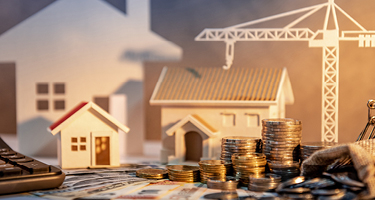The last few years have seen significant changes in the business world: the COVID-19 pandemic, rising inflation and interest rates, work-from-home trends, supply chain problems, the rise of ESG in corporate boardrooms and more. To the outside world, real estate appears immune from these current developments. For those involved in real estate development, however, the impacts are very real.
The Impact of the Pandemic and Inflation on Real Estate Projects
Real estate markets have been greatly affected by the COVID-19 pandemic and the resulting economic impacts of inflation and supply chain disruption. The shift to a “work from home” mentality has adversely impacted traditional office markets. Fewer people working in the office has resulted in a “flight to quality”—those that remain in the office want nicer surroundings and better amenities. The older class C/D office buildings are slowly emptying and becoming ripe for redevelopment, often being converted to residential spaces.
The uptick in “shop-from-home” has also had a significant impact on warehouse and industrial real estate. The desire for last mile delivery has caused warehouses to pop up everywhere—who hasn’t seen a new Amazon warehouse go up in the last few years? That warehouse expansion has tightened the market for industrial and manufacturing space.
Affecting all real estate markets, however, are inflation and supply chain disruption. The most obvious impact of inflation on real estate markets is the rise in interest rates. Rising interest rates mean an increase in the cost of capital and a resulting increase in rental rates. Compounding the increased cost of capital is the impact of supply chain disruption. The cost of a new build project is substantially higher and more unpredictable than it was a few years ago. With the uncertainty in the cost and supply of materials needed to build a new project, construction contractors are hesitant to take on any risk in contracts. A few short years ago, a contractor might eagerly undertake a fixed fee project with per-diem penalties for delayed delivery; now, however, with the constantly rising cost of goods and the uncertainty in the supply chain, contractors are passing those risks back to the owner. Consequently, real estate development projects are costlier and more uncertain.
Where Can Real Estate Developers/Owners Look for Relief From Inflation and Supply Chain Disruption?
Despite the economic headwinds from COVID-19, inflation and supply chain disruption, new real estate projects are still getting done. Savvy developers and owners are investigating and using all available resources to overcome the economic headwinds. Federal, state and local governments have undertaken a multitude of economic development programs and incentives to help facilitate investment in new real estate projects. For example, look at Intel’s $20 billion investment in a new semiconductor manufacturing plant near Columbus, Ohio. It is reported that Intel is set to receive approximately $2 billion through tax incentives, onshoring credits and other programs.
Federal, state and local governments have undertaken a multitude of economic development programs and incentives to help facilitate investment in new real estate projects."
These incentives—whether they come in the form of direct grants, tax incentives, tax increment financing (TIF), Community Reinvestment Act (CRA), forgivable loans, brownfield revitalization grants, Opportunity Zones, New Market Tax Credits, Historic Tax Credits or a myriad of other programs—often bridge the gap in making a project happen. While many of these incentives attach strings like job creation or retention, any savvy real estate developer would be negligent not to at least investigate these opportunities. Contact the local Economic Development Director or hire a professional to advise you with respect to available incentives. Communities want new jobs for their residents and investments funneled into their local community. Identifying and capturing these incentives can often make the difference in bringing a project to fruition.
The Impact of ESG on Real Estate Development Projects
Social awareness is a growing trend throughout the corporate sector, and the real estate market is no exception. The concept of “ESG”—Environmental, Social, Governance—has become a particularly relevant consideration for real estate developers and investors wanting to embrace sustainable and modern approaches. In the wake of the COVID-19 pandemic, together with the supply chain, workforce and inflation challenges that have come with it, ESG is being embraced in more and more corporate boardrooms. As more corporate boardrooms embrace ESG, they are going to demand that real estate developers do so as well.
ESG encompasses mandatory (or regulatory) requirements as well as voluntary initiatives. Voluntary initiatives must be considered and weighed by real estate investors and developers as they plan projects. How much do the initiatives cost in the short term versus added long-term value and social and customer acceptance? Further, ESG requirements and regulations can vary by jurisdiction and need to be considered.
The “E” in ESG challenges developers to be environmentally conscious as they undertake real estate projects and to develop infrastructure that will benefit not just the tenants of today but also the communities of tomorrow. This means not only considering energy-saving and carbon-offsetting components in new developments but also ensuring the construction activities for those developments are carried out with environmentally friendly techniques and materials.
The “S” in ESG puts a much broader focus on the “community as a whole” when approaching new real estate developments. Developers and investors can’t overlook the immediate needs of a particular tenant of a development, but they should also consider the impact of the development on the surrounding community. Further, the Social in ESG puts an increasing emphasis on the adaptive reuse of existing developments. How can a developer redevelop a run-down project into a profitable development that benefits the broader community as well?
The “G” in ESG challenges all businesses, including real estate developers and owners, to operate their businesses in a responsible, transparent and inclusive manner. A corporation’s purpose, the persons responsible for corporate decisions and how performance is measured are key factors in evaluating Governance. Is the board or other group of decision-makers inclusive and representative of the community? Is compensation equitable, and what oversight do shareholders have on compensation and board composition? Attention to the Governance aspect of ESG is critical as social, cultural and political attitudes continue to evolve. While much of the ESG movement is comprised of voluntary initiatives, a prudent real estate developer will evaluate and incorporate the relevant tenets of ESG into future projects.
While real estate is not immune from the economic impacts of COVID-19, inflation and supply chain issues, creative developers will still find a way to get deals done. Maximizing available governmental incentives, paying close attention to the new issues raised in construction contract negotiations, embracing the effective aspects of ESG and focusing on the hot markets will help developers and investors maximize the value out of their real estate investment.
David A. Lum is a principal at McCarthy Lebit Crystal and Liffman with 30 years of experience in real estate, corporate and business Law and mergers and acquisitions. In his real estate practice, David has extensive experience handling all aspects of the corporate real estate life cycle, including acquisition, development, leasing, financing, divestiture, condemnation and property tax contests. David has been recognized for his high caliber work in Real Estate Law and Corporate Law by The Best Lawyers in America® (2013-2023) and Ohio Super Lawyers®.

































